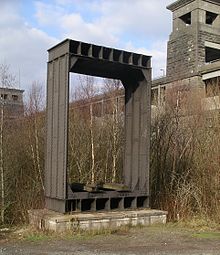
Back الجائز الصندوقي Arabic Hohlkasten German Viga cajón Spanish Poutre-caisson French Szekrénytartó Hungarian Lådbalk Swedish 箱梁 Chinese



A box girder or tubular girder (or box beam) is a girder that forms an enclosed tube with multiple walls, as opposed to an Ɪ- or H-beam. Originally constructed of wrought iron joined by riveting, they are now made of rolled or welded steel, aluminium extrusions or prestressed concrete.
Compared to an Ɪ-beam, the advantage of a box girder is that it better resists torsion. Having multiple vertical webs, it can also carry more load than an Ɪ-beam of equal height (although it will use more material than a taller Ɪ-beam of equivalent capacity).
The distinction in naming between a box girder and a tubular girder is imprecise. Generally the term box girder is used, especially if it is rectangular in section. Where the girder carries its "content" inside the "box", such as the Britannia Bridge, it is termed a tubular girder. Tubular girder is also used if the girder is round or oval in cross-section, such as the Royal Albert Bridge.
Where a large box girder contains more than two walls, i.e. with multiple boxes, it is referred to as a cellular girder.